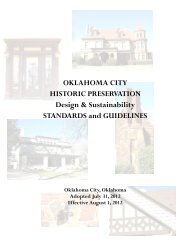The Cost of Homelessness in Oklahoma City April 1, 2009 to March ...
The Cost of Homelessness in Oklahoma City April 1, 2009 to March ...
The Cost of Homelessness in Oklahoma City April 1, 2009 to March ...
Create successful ePaper yourself
Turn your PDF publications into a flip-book with our unique Google optimized e-Paper software.
<strong>Oklahoma</strong> <strong>City</strong> <strong>Cost</strong> <strong>of</strong> <strong>Homelessness</strong> Study <strong>2009</strong>‐2010<br />
STUDY CHALLENGES<br />
<strong>The</strong> <strong>Cost</strong> Study process brought <strong>to</strong>gether a wide variety <strong>of</strong> homeless and ma<strong>in</strong>stream service<br />
providers who share a commitment <strong>to</strong> help<strong>in</strong>g <strong>Oklahoma</strong> <strong>City</strong>’s homeless community but do<br />
not <strong>of</strong>ten collaborate <strong>to</strong> reach a common goal. Because homeless services <strong>in</strong> OKC are<br />
dedicated <strong>to</strong> ma<strong>in</strong>ta<strong>in</strong><strong>in</strong>g comprehensive records, the <strong>Cost</strong> Study Committee was able <strong>to</strong><br />
collect and analyze a substantial amount <strong>of</strong> <strong>in</strong>formation <strong>in</strong> a relatively short period <strong>of</strong> time,<br />
and we are confident that the numbers provided are accurate. However, we encountered<br />
numerous challenges <strong>in</strong> our data collection process that narrowed the overall scope <strong>of</strong> the<br />
study and ultimately restricted the amount <strong>of</strong> <strong>in</strong>formation <strong>in</strong>cluded <strong>in</strong> the F<strong>in</strong>al Report.<br />
Homeless Numbers – Many participat<strong>in</strong>g agencies do not track <strong>in</strong>dividual client data; for our<br />
purposes, they were able <strong>to</strong> provide nightly bed counts but could not determ<strong>in</strong>e if the same<br />
clients are be<strong>in</strong>g served from day <strong>to</strong> day. Additionally, some <strong>of</strong> the agencies that provided<br />
monthly data were not able <strong>to</strong> provide unduplicated client counts for the study period. <strong>The</strong><br />
study process <strong>in</strong>spired several agencies <strong>to</strong> develop better client track<strong>in</strong>g methods.<br />
Homeless/Non‐Homeless Client Numbers – Many agencies that serve both homeless and<br />
non‐homeless clients have no way <strong>of</strong> separat<strong>in</strong>g their client numbers or <strong>of</strong> isolat<strong>in</strong>g the cost<br />
<strong>of</strong> serv<strong>in</strong>g only their homeless clients. Some food pantries, free cl<strong>in</strong>ics, and the Public<br />
Inebriate Alternative could not be <strong>in</strong>cluded <strong>in</strong> the <strong>Cost</strong> Study for that reason.<br />
Demographics – Most participat<strong>in</strong>g programs do not record demographic <strong>in</strong>formation; many<br />
that record demographic <strong>in</strong>formation do so only partially and sporadically. Few agencies<br />
were able <strong>to</strong> provide complete demographic data that matched their client numbers.<br />
Ultimately, the <strong>Cost</strong> Study Committee concluded that the partial demographic data collected<br />
was not sufficient <strong>to</strong> constitute a representative data set and should be left out <strong>of</strong> the F<strong>in</strong>al<br />
Report.<br />
Unit <strong>Cost</strong>s – Services <strong>to</strong> homeless are many and varied, and develop<strong>in</strong>g a common def<strong>in</strong>ition<br />
for “unit <strong>of</strong> service” was not possible. Even with<strong>in</strong> a service category, a unit <strong>of</strong> service can<br />
vary greatly from agency <strong>to</strong> agency, depend<strong>in</strong>g on the amount and level <strong>of</strong> services available<br />
on site. We developed and provided def<strong>in</strong>itions and <strong>of</strong>fered guidance but ultimately trusted<br />
the agency’s judgment when calculat<strong>in</strong>g service units.<br />
Fund<strong>in</strong>g Sources – In order <strong>to</strong> understand the level <strong>of</strong> support from each government<br />
category (i.e., Federal, State, County, <strong>City</strong>), providers were asked <strong>to</strong> complete a “Fund<strong>in</strong>g<br />
Sources” form that listed specific (and typical) grant and program categories. <strong>The</strong>y were<br />
asked <strong>to</strong> provide the <strong>Cost</strong> Study Committee with <strong>in</strong>formation about the sources <strong>of</strong> all <strong>of</strong> the<br />
fund<strong>in</strong>g that they had reported on their cost study forms. Difficulties arose, as the <strong>to</strong>tals<br />
(taken from budgets) <strong>of</strong>ten differed from the actual amount spent dur<strong>in</strong>g the <strong>Cost</strong> Study<br />
Spangler & Associates, Inc. Page 41

















